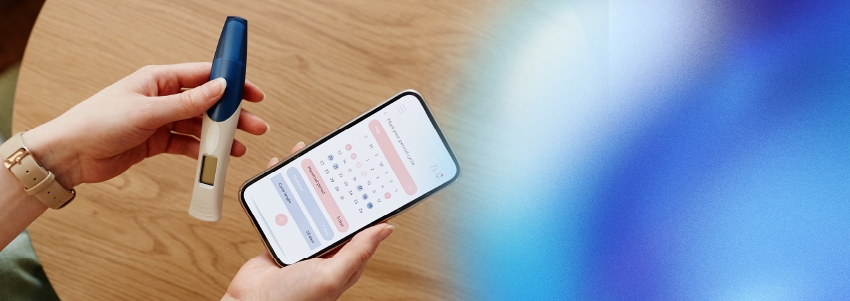Dr. Kelsey Stang

Educating women on effective and sustainable ways to track fertile signs with at-home methods has many benefits beyond achieving pregnancy.
While understanding fertile signs and the fertile window (FW) can increase chances of a natural pregnancy, it can also help identify potential hormone imbalances, causes of symptoms as well as effectively prevent pregnancy when used to avoid intercourse during the FW. Additionally, utilizing the signs and symptoms of the body and consistent monitoring from the patient can potentially avoid using invasive testing, in some cases (1).
Benefits of tracking fertility parameters extends to empowering women with a better understanding of their bodies, their fertility and navigating symptoms from an objective place. As practitioners, we have an advantage as our patient already has historical data of cycle patterns to inform an understanding of hormone balance even before doing more in depth testing.
Understanding the details of physiology as well as practicality for our patients is very important. Anytime we’re asking our patients to implement a daily change to their lifestyle, it helps to know the ins-and-outs of the process ourselves. This article walks through the most common and effective ways to track fertile parameters as well as possible limitations to be cautious of.
When should a person with female anatomy begin tracking their cycles?
Incorporating fertility tracking when someone discontinues birth control or hormonal contraceptives is a great way to begin tracking restoration of normal hormone flow.
Additionally, any woman who is wanting to get pregnant, who is wanting to avoid pregnancy or who is wanting to cultivate a deeper understanding of their cycle + symptoms each month would all be great candidates for better understanding and utilizing fertility tracking.
Ways to track fertility parameters
Ovulation Predictor Kit (OPK):
OPK is an at-home measurement of luteinizing hormone (LH) collected by the patient, ideally with the second morning urine void. This urine strip measures presence of LH in the urine, indicating the signal for ovulation has begun. There are many products available OTC for this test.
A very common limitation to this measurement is in patients with diagnosed or undiagnosed Polycystic Ovarian Syndrome (PCOS). Hyperandrogenemia associated with PCOS leads to a pulsatile secretion of LH and more persistently elevated levels of LH due to hyperactive GnRH secretion (2). This can lead to many false positives in this patient population and can make tracking ovulation challenging.
One study found testing a statistically significant benefit to measuring LH test and peak cervical mucus together to identify FW (rather than either mucus or LH testing alone), which suggests an importance of gathering multiple data points when assessing FW (3).
Basal Body Temperature:
It is expected that following ovulation, a woman’s basal body temperature (BBT) rises by roughly 0.5 – 1.0 * F. This happens due to the presence of progesterone which is secreted from the corpus luteum following ovulation. Progesterone signals the hypothalamus to increase body temperature slightly. BBT should remain above baseline for the duration of the luteal phase, roughly 10-14 days, returning to baseline around day 1 of the next menstrual period. If basal body temperature does not return to baseline, that can be an indication of early pregnancy.
The biggest limitation of measuring BBT is that it needs to be recorded at the same time of day, every day, immediately upon waking. This poses many logistical issues for people who work irregular shifts, have young children at home or have disrupted sleep patterns.
Other important factors to consider are that measurements are subject to environmental influences such as fever or secondary infection, emotional stress, alcohol consumption, changes to hormonal contraceptives and thyroid medication, which can all cause slight fluctuations in temperature and make tracking difficult to pinpoint (4).
Of consideration to the limitation of needing to take one’s temperature every day at the same time, wearable and consistent monitoring devices have proven to be reliable and controls for some of the confounding factors that can influence reliable data.
Cervical Mucus:
A notable increase of estrogen prior to ovulation results in a secretion of thicker and more copious cervical mucus (CM). This can easily be measured by women either observing changes to vaginal lubrication or by inserting 1 finger vaginally to gather and assess quantity and consistency of mucus.
Fertile mucus is often referred to as “egg white cervical mucus (EWCM)” based on its thicker and more creamy consistency. Monitoring and keeping track of the presence and quality of CM can effectively insight when a woman’s fertile window is (5). Average presence of CM during the fertile window can be up to 6 days with peak EWCM lasting 1-3 days, but the range can vary.
Limitations in tracking this parameter include patients not knowing how to categorize their CM, to which educational resources can be supportive. If there is a concomitant vaginal infection that could make assessment of cervical mucus confusing and unreliable.
Despite the few limitations, assessment of CM is generally a reliable and effective way to assess fertile window (6).
Advanced Hormone Testing:
When at-home assessments are not providing clinical outcomes, layering in more in-depth assessment may be necessary. This testing can include cycle specific serum laboratory testing (for effectiveness testing for E2, LH, FSH on CD 2 or 3 and 17 OH progesterone at 7 days post ovulation), pelvic ultrasound, as well as comprehensive hormone testing.
The clinical benefits of comprehensive testing are vast and can help practitioners identify specific ways to support hormone balance, identify and optimize the fertile window for their patients as well as provide data and clinical education for their patients.
In conclusion, there are numerous benefits to assessing fertility parameters for women who are trying to conceive and those who are deepening their understanding of their own cycles. These assessments can provide clarity for the provider as to how best to support the patient whether for symptom management, fertility or contraception.
References
- Thijssen A, Meier A, Panis K, Ombelet W. ‘Fertility Awareness-Based Methods’ and subfertility: a systematic review. Facts Views Vis Obgyn. 2014;6(3):113-23. PMID: 25374654; PMCID: PMC4216977.
- Coutinho EA, Kauffman AS. The Role of the Brain in the Pathogenesis and Physiology of Polycystic Ovary Syndrome (PCOS). Med Sci (Basel). 2019 Aug 2;7(8):84. doi: 10.3390/medsci7080084. PMID: 31382541; PMCID: PMC6722593.
- Leiva RA, Bouchard TP, Abdullah SH, Ecochard R. Urinary Luteinizing Hormone Tests: Which Concentration Threshold Best Predicts Ovulation? Front Public Health. 2017 Nov 28;5:320. doi: 10.3389/fpubh.2017.00320. Erratum in: Front Public Health. 2018 Nov 30;6:345. PMID: 29234665; PMCID: PMC5712333.
- Steward K, Raja A. Physiology, Ovulation And Basal Body Temperature. [Updated 2023 Jul 17]. In: StatPearls [Internet]. Treasure Island (FL): StatPearls Publishing; 2023 Jan-. Available from: https://www.ncbi.nlm.nih.gov/books/NBK546686/
- Bigelow JL, Dunson DB, Stanford JB, Ecochard R, Gnoth C, Colombo B. Mucus observations in the fertile window: a better predictor of conception than timing of intercourse. Hum Reprod. 2004 Apr;19(4):889-92. doi: 10.1093/humrep/deh173. Epub 2004 Feb 27. PMID: 14990542.
- Evans-Hoeker E, Pritchard DA, Long DL, Herring AH, Stanford JB, Steiner AZ. Cervical mucus monitoring prevalence and associated fecundability in women trying to conceive. Fertil Steril. 2013 Oct;100(4):1033-1038.e1. doi: 10.1016/j.fertnstert.2013.06.002. Epub 2013 Jul 11. PMID: 23850303; PMCID: PMC3787999.


